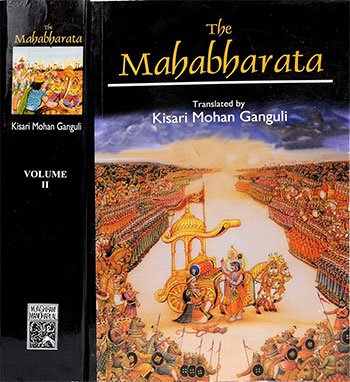Section CCLXXXIX - Rama's Return and Coronation: Markandeya's Account
Book index: Mahabharata (English)
This page contains a summary of the Mahabharata Section CCLXXXIX including examples of moral lessons in daily life. The Maha-Bharata is one of the largest epics ever written containing roughly 100,000 Sanskrit verses. It deals with the legendary history of ancient India and contains a large number of interwoven tales.
Short summary of the chapter:
After Rama defeated Ravana and rescued Sita, he was honored by the celestials and given back the kingdom of Lanka. However, Rama hesitated to accept Sita as his wife due to suspicions raised during her captivity. After a divine intervention from Wind god, Fire god, Varuna, Brahma, and even Rama's father Dasaratha, it was revealed that Sita was pure and innocent. Rama then reunited with Sita, and with the blessings of the gods, he ruled Ayodhya for fourteen years as rightful king.
Rama also granted boons to his allies and restored the lives of the monkeys killed in battle. Sita blessed Hanuman with a long life and divine provisions. The celestial beings disappeared, leaving Rama and his allies to return to Ayodhya. Rama, along with Sita, his brother Lakshmana, and allies like Vibhishana and Hanuman, crossed the ocean in the Pushpaka chariot and reached Ayodhya.
Upon reaching Ayodhya, Rama enthroned Angada as prince-regent in Kishkindhya and reunited with Bharata and Shatrughna. Bharata happily returned the kingdom to Rama and placed his sandals on the throne as a symbol of his loyalty. Rama was then officially installed as the king of Ayodhya by the sage Vasishtha. After his installation, Rama conducted ten horse sacrifices along the banks of the Gomati river with the assistance of Vasishtha, solidifying his reign and ensuring prosperity for his kingdom.
Rama's reign was marked by peace and prosperity, and he ruled justly and wisely, following the path of virtue and righteousness. He maintained good relations with his allies, such as Sugriva and Vibhishana, and honored them for their support. The people of Ayodhya revered Rama for his valor, compassion, and adherence to Dharma. Rama's legacy as a righteous king and a symbol of virtue lived on for generations to come.
Full English translation:
This page is merely a summary which is automatically generated. If you are looking for authentic sources such as the Sanskrit text or the Full English translation of Mahabharata Section CCLXXXIX - Rama's Return and Coronation: Markandeya's Account, have a look at the following articles:
Section CCLXXXIX, online text
English translation by Kisari Mohan Ganguli.
Read this and other chapters online.
Mahabharata (English Summary)
by Kisari Mohan Ganguli | ISBN-10: 8121505933
Buy the latest edition:
FAQ of Mahabharata, Section CCLXXXIX:
What did Rama do after slaying Ravana?
Rama gave Lanka to Vibhishana, freed Sita, and returned to Ayodhya. He then performed ten horse-sacrifices with Vasishtha's assistance.
How did Sita prove her innocence?
Sita invoked the gods to forsake her if she had sinned. Wind, Fire, and others affirmed her purity, convincing Rama to accept her.
What boons did Rama ask of Brahma?
Rama requested firm adherence to virtues, invincibility against foes, restoration of slain monkeys, and long-lasting fame for Hanuman.
How did Rama reunite with Bharata and Shatrughna?
Rama returned to Ayodhya, where Bharata surrendered the kingdom and Rama was officially crowned with Vasishtha and Vamadeva's assistance.
Daily life: Rama's Return and Coronation: Markandeya's Account:
The story of Rama, after he overcomes the malevolent Ravana and reunites with Sita, brings forth several moral lessons that can be integrated into daily life. First, it teaches the importance of courage and perseverance in the face of adversity. Just as Rama faces numerous challenges but remains steadfast in his quest, individuals should strive to confront obstacles with bravery, keeping their goals and principles in sight.
Another lesson is the value of forgiveness and understanding. When Sita is questioned by Rama, it reflects societal judgments, yet the divine testimonies validate her purity, demonstrating that judgments should be reserved, and understanding should prevail in relationships. It shows the merit of seeing beyond appearances and societal pressures, encouraging trust and empathy in personal interactions.
The act of bestowing Lanka to Vibhishana symbolizes the nobility in recognizing and rewarding loyalty and righteousness. It teaches that acknowledging the contributions and loyalty of others reinforces positive relationships and builds a community based on mutual respect.
Additionally, the reunion and celebration with allies highlight the importance of gratitude and recognition towards those who support us in our journey. It reminds individuals to acknowledge the roles others play in their lives, fostering a culture of appreciation and gratitude.
Lastly, Rama's return and the rightful assumption of his role as the king underscore the significance of duty and responsibility. It advocates for fulfilling one's roles within their community or family with integrity and dedication, ensuring the wellbeing of all members.
In essence, the story of Rama offers timeless lessons on leading a life marked by bravery, understanding, loyalty, gratitude, and a sense of duty, values that enhance personal character and societal harmony.
